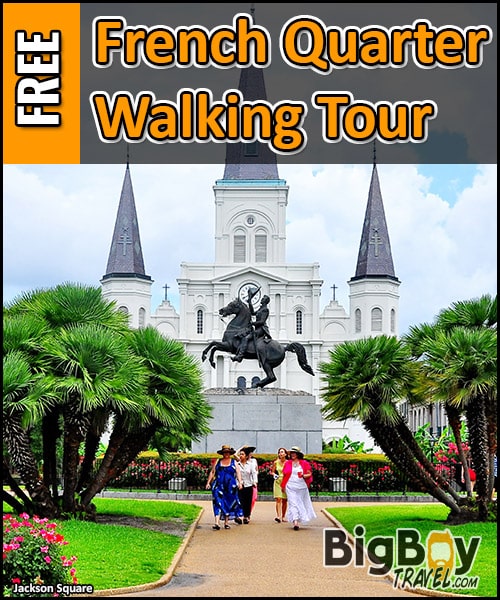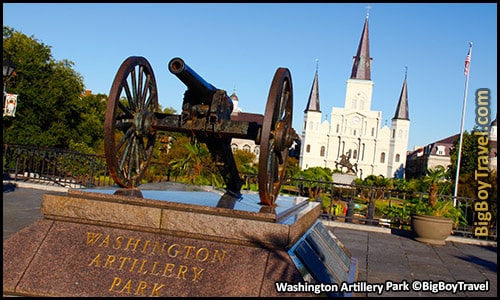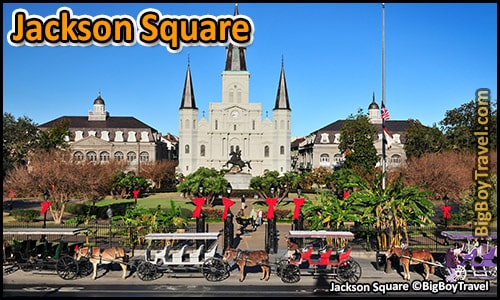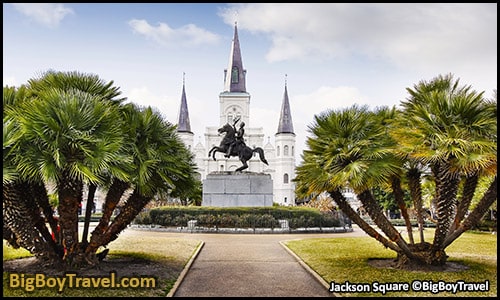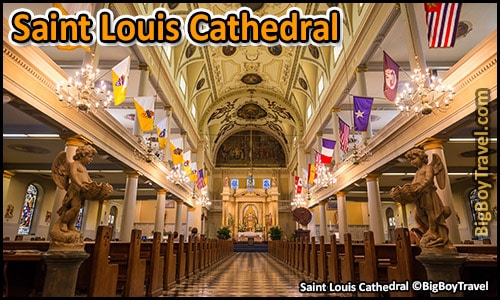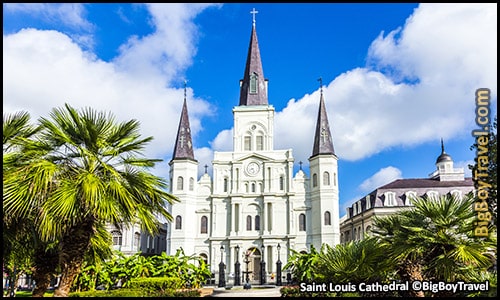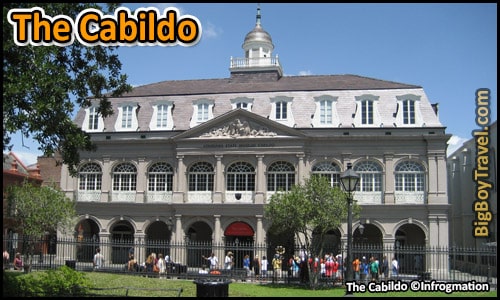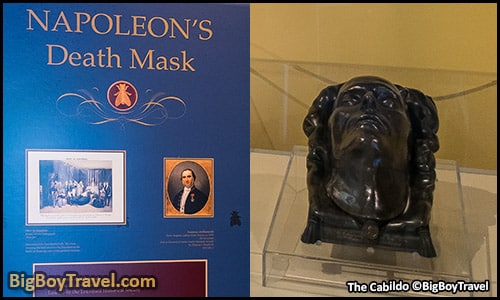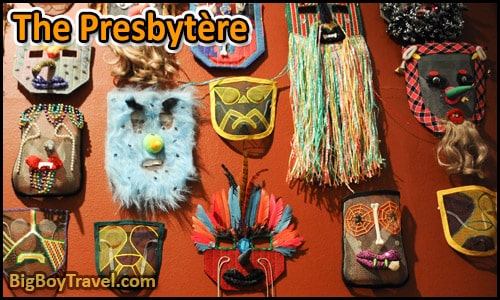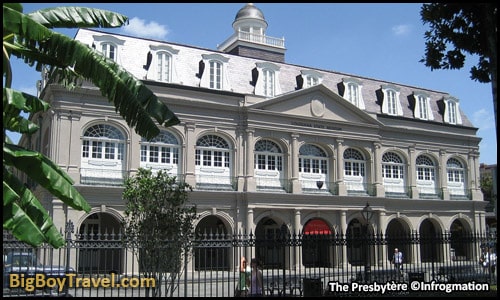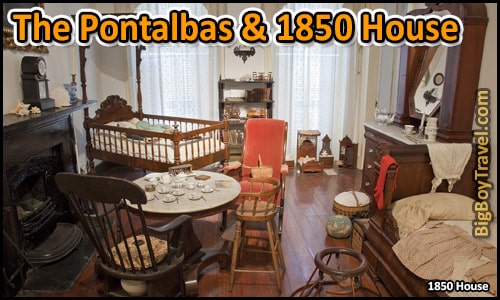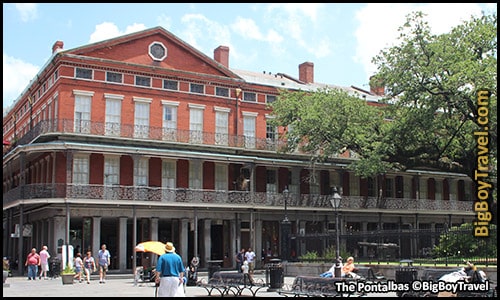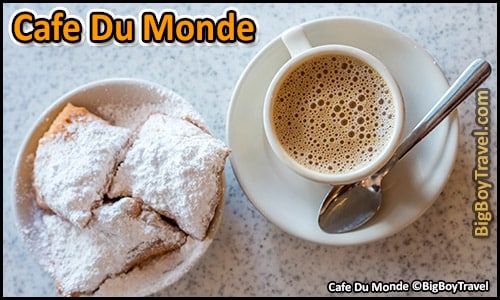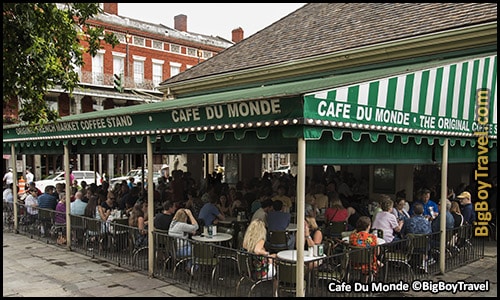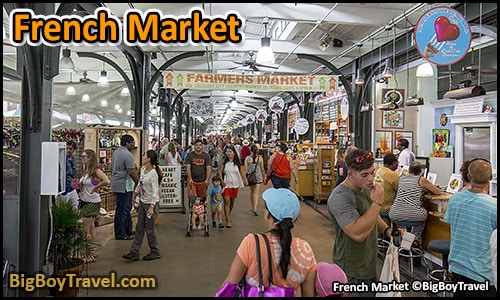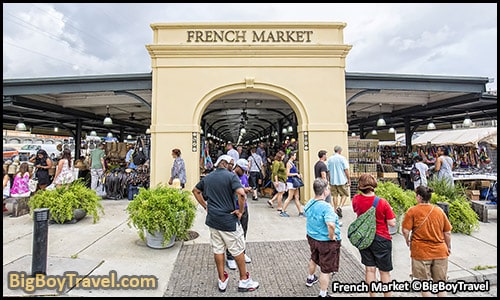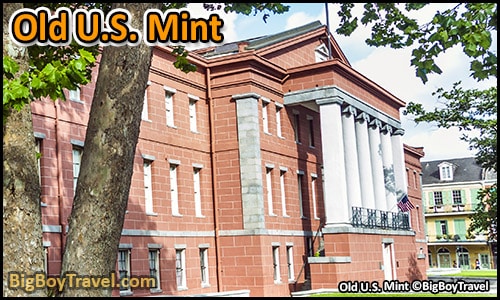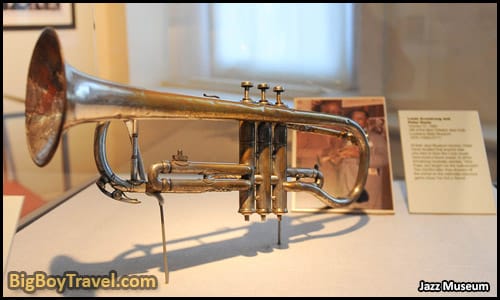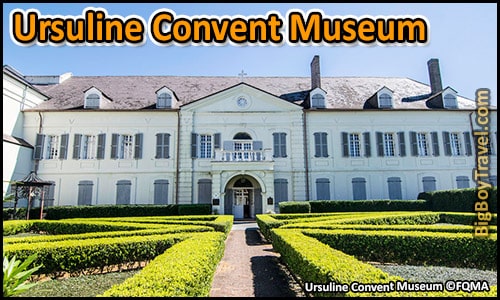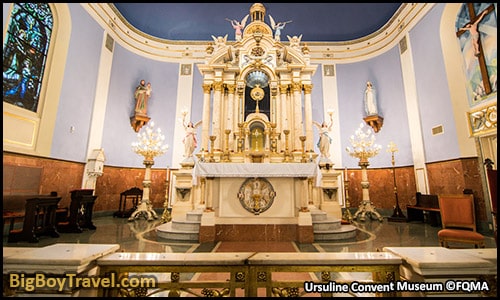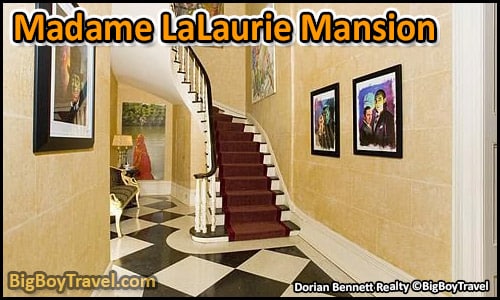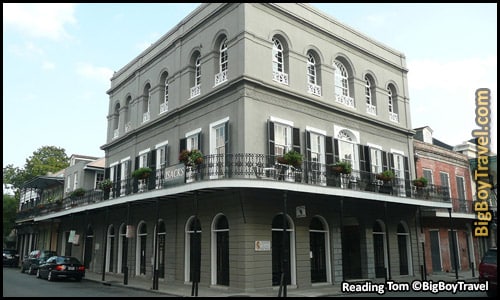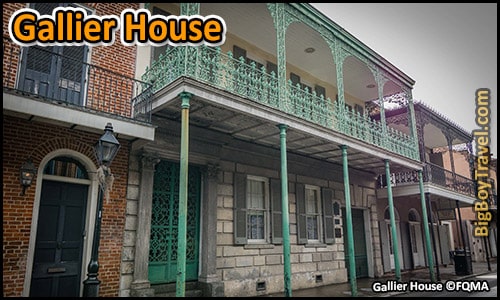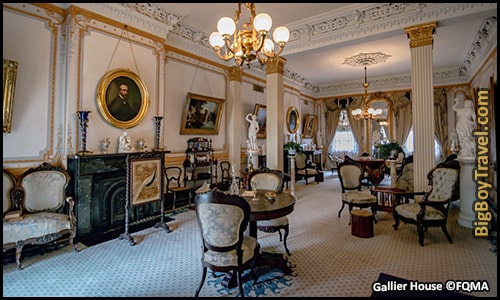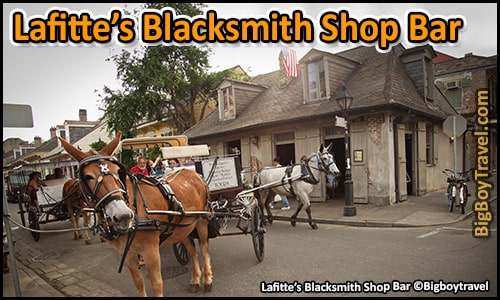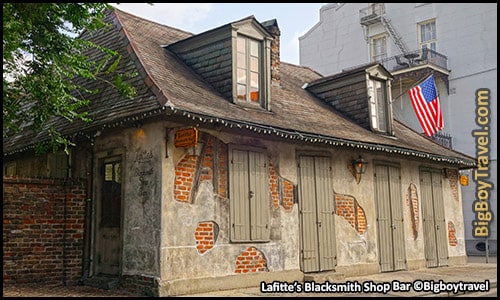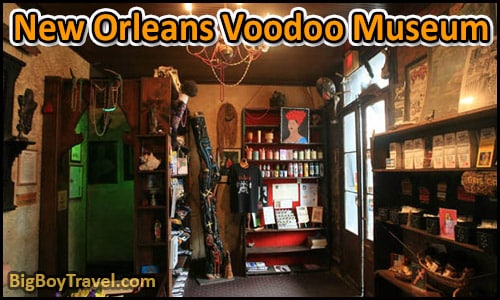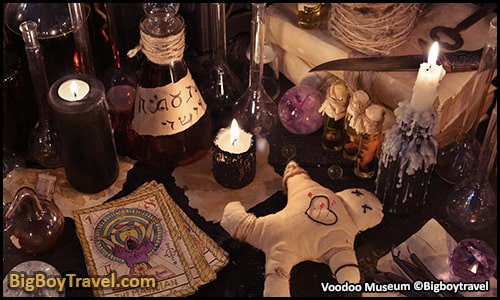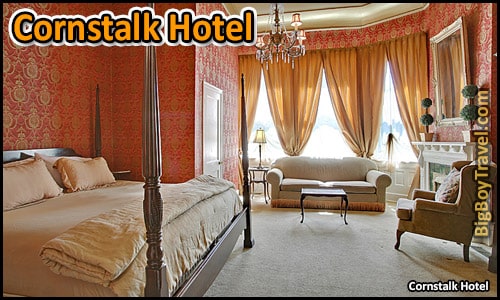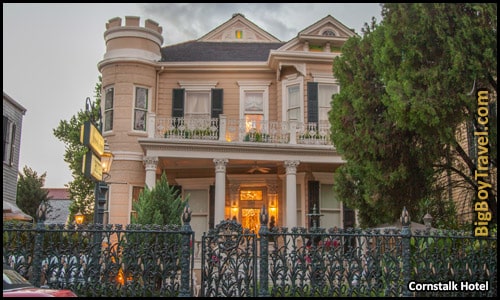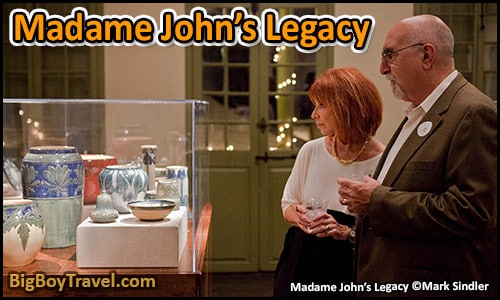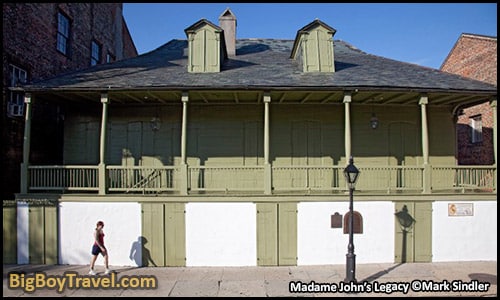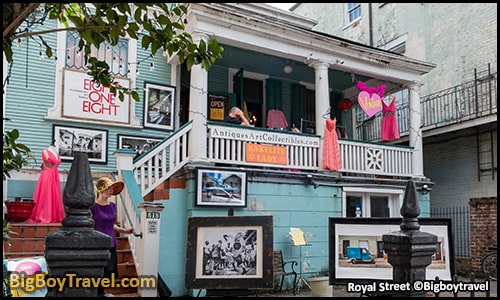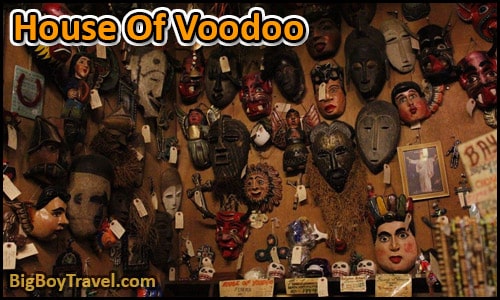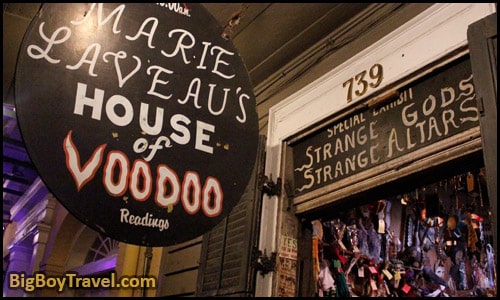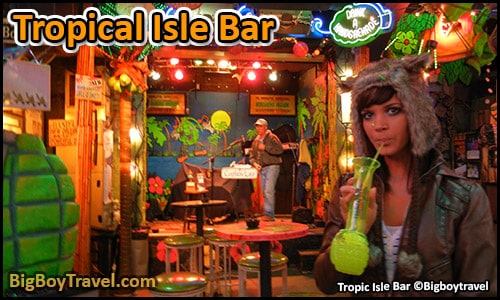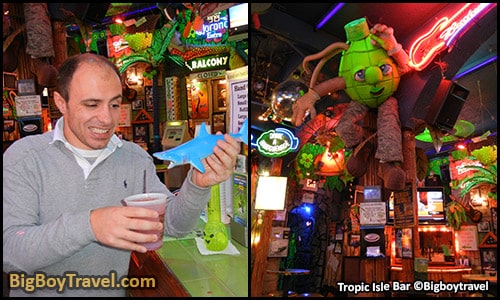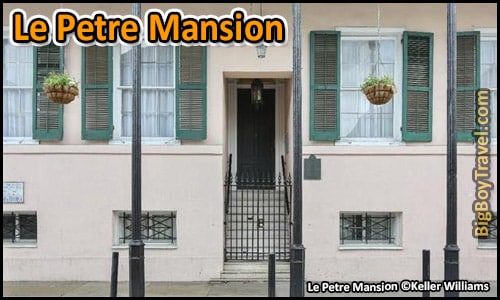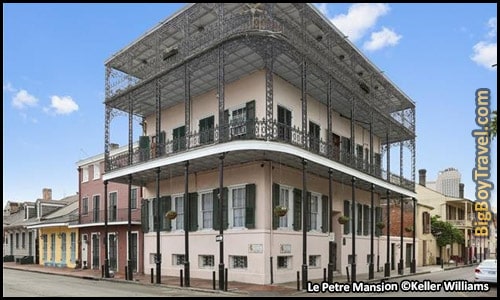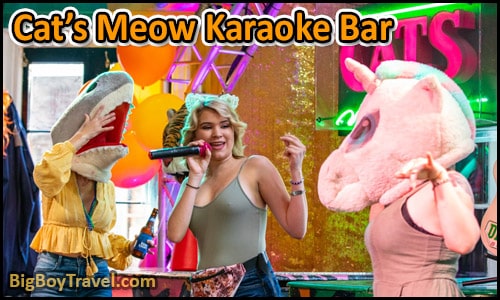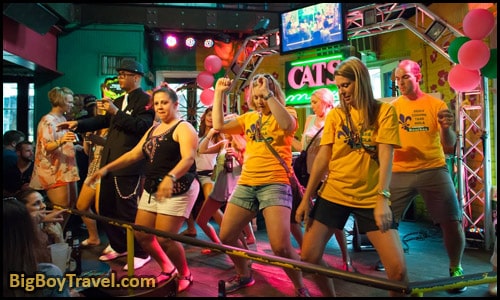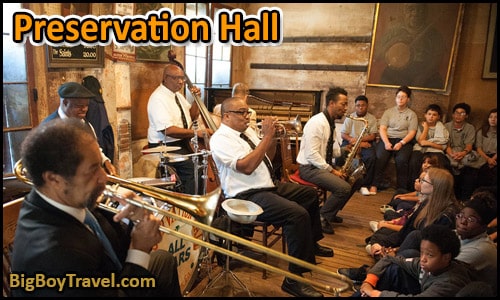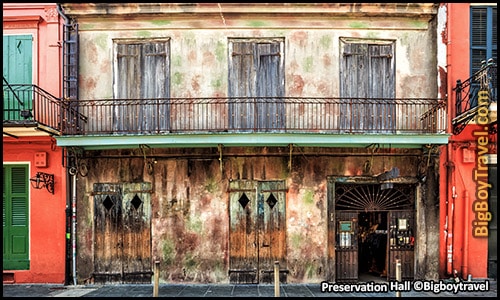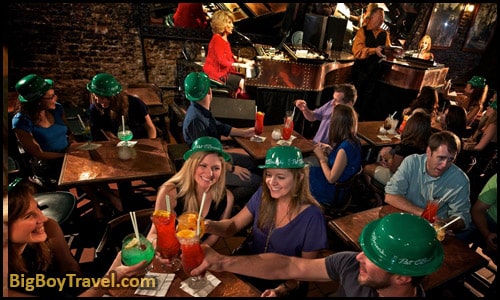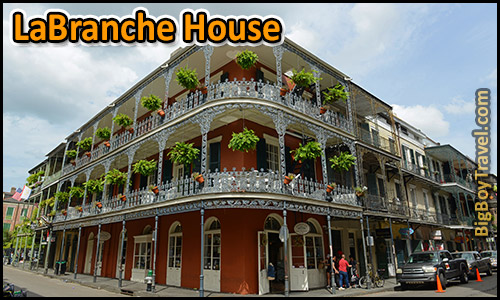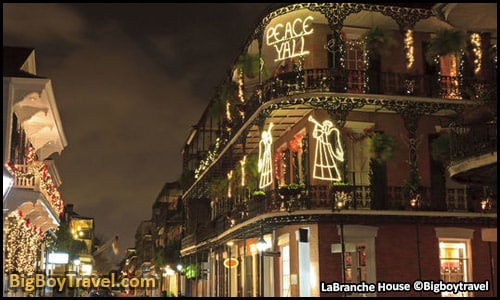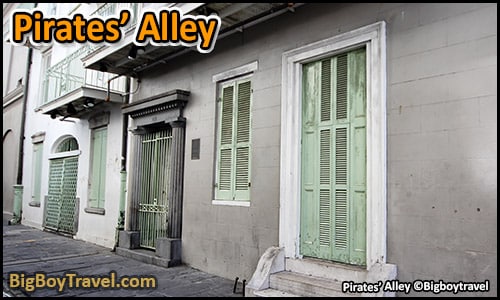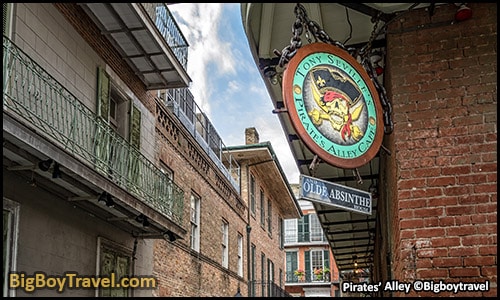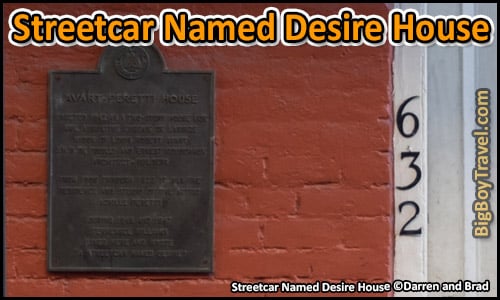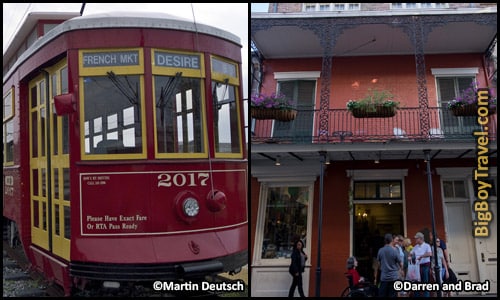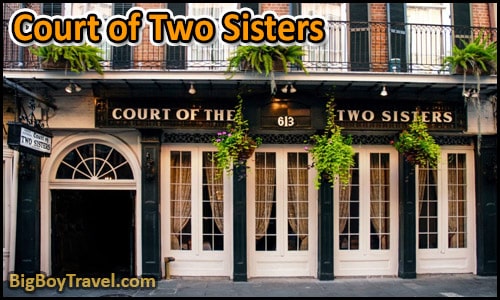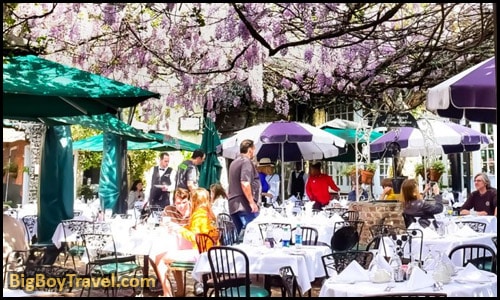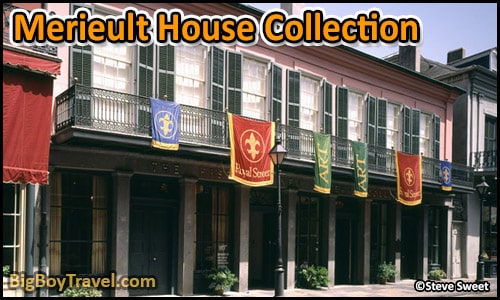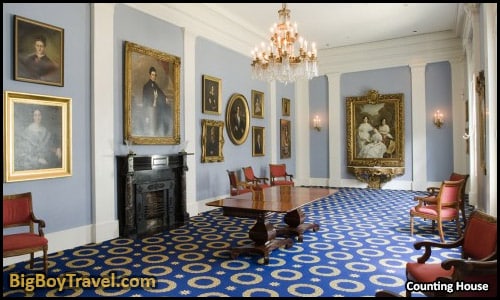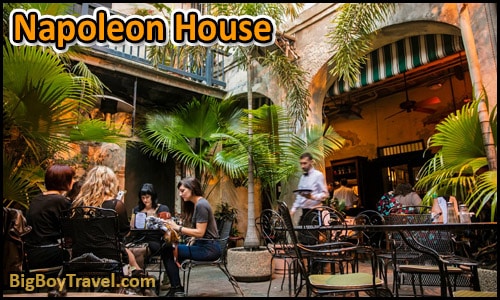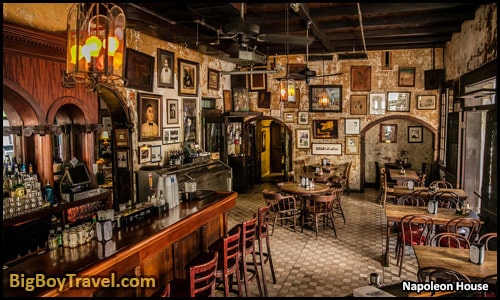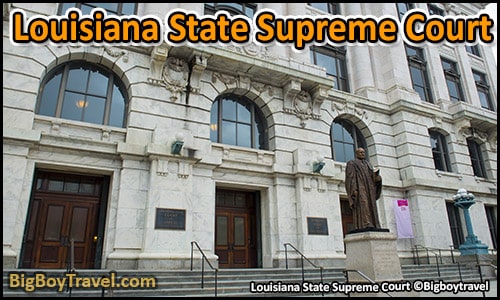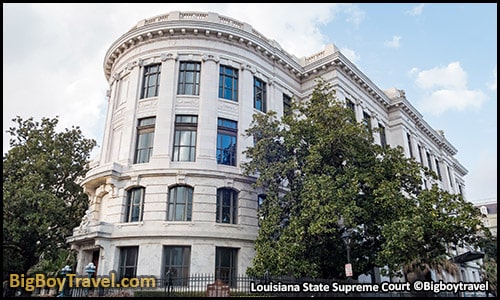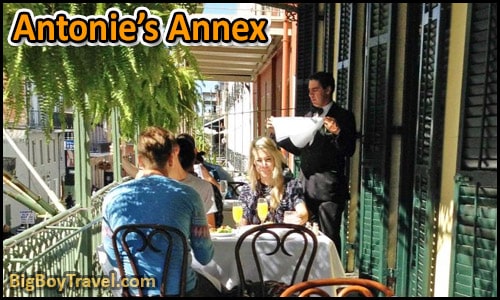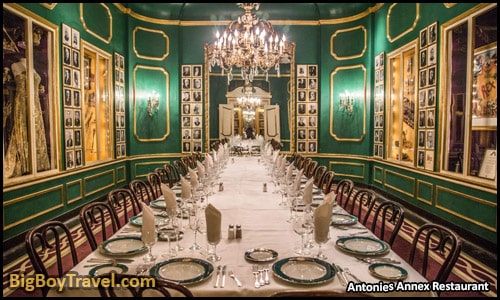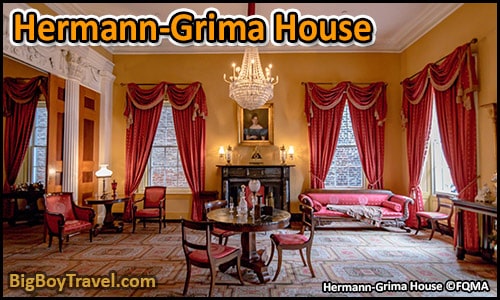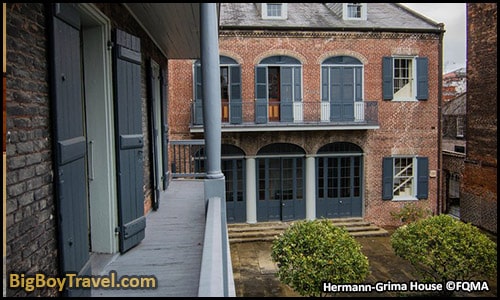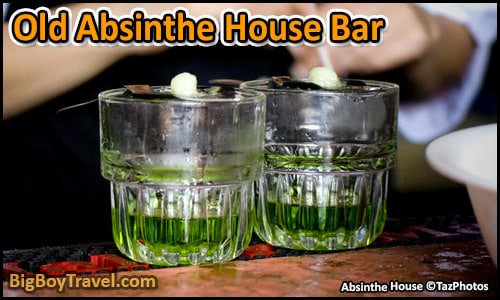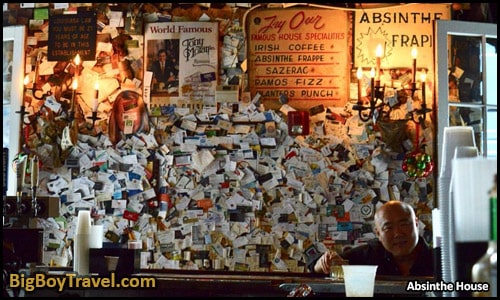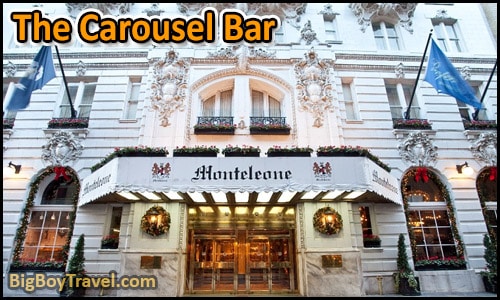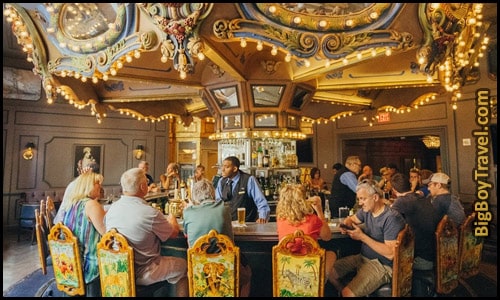French Quarter Walking Tour:
Location: French Quarter New Orleans
Cost: Free, Self-Guided (Optional costs listed below)
Style: Do-It-Yourself Walking Tour (Self Guided)
Starting Point: Washington Artillery Park & Terrace
End Of Tour: The Carousel Bar
Walking Distance: 2.5 miles of walking (-0.5 if you skip stops 9-13)
Time Required: 2 Hours of walking (+a few hours for food and drink)
Fun Scale: 9.5 out of 10
Overview of the French Quarter:
Our free, self-guided French Quarter walking tour will put you in the center of the cultural heartbeat of New Orleans for an unforgettable experience. Originally called the Vieux Carré (pronounced Vue Ca-Ray), or Old Square in French, the French Quarter has vibrant roots dating long before New Orleans was officially founded in 1718. From local Native Americans as early as 400AD to European settlers and slaves centuries later, the French Quarter grew as a blend of many cultures. By its heyday in the mid-1800s, the French Quarter was a thriving melting pot of French, Spanish, African, Native-American, and Creole heritage.
Today the unique mix of culture shines through the French Quarter with bursts of colorful festivals, hints of voodoo, live jazz music, an unbeatable bar district and some of the best food in the country. New Orleans is often considered the most unique city in the world and its all on display in the French Quarter. We hope you enjoy our do-it-yourself French Quarter walking tour!
French Quarter Walking Tour Sights:
1. Washington Artillery Park & Terrace (768 Decatur Street):
About Washington Artillery Park: While often overlooked by tourists, we love to start our French Quarter walking tour on the perch of Washington Artillery Park & Terrace. The park is actually on top of a levee that was enhanced in the 1800s to protect New Orleans from the flood waters of the Mississippi River. With its elevated position over Jackson Square to one side and the mighty Mississippi River on the other, the stunning views from the terrace really help you get a lay of the land. It is no wonder that this position was used by the French, Spanish, Confederates, and Americans to defend New Orleans over the centuries. A memorial in the middle of the terrace pays homage to its history as a military battery with a Civil War-era cannon always on guard. The cannon is a model 1861 Parrot Rifle used in the Civil War and is dedicated to the local 141st Field Artillery of the Louisiana National Guard.
Looking toward the Mississippi River from the terrace, you’ll see a delightful waterfront walking path known locally as the Moonwalk. If you hunt you for it, will also find a marker for the New Orleans Steamer which landed here in 1812 as the 1st steamboat to navigate both the Ohio and Mississippi Rivers to the Gulf of Mexico.
Before leaving the terrace, make sure to take in the perspective of the Saint Louis Cathedral and the horse-drawn carriages that line the front of the Jackson Square below you. A ton of carriage companies are available on standby to take you anywhere you want in the French Quarter and Garden District, but our favorite is Royal Carriages (website). As you descend toward the carriages, make note of the stepped amphitheater where you can often watch some great street performers in action.
2. Jackson Square (700 Decatur Street):
About Jackson Square: For as much fanfare Bourbon Street gets, the real heart of New Orleans has always been Jackson Square. Soon after the French founded the city in 1718, they began carefully planning New Orleans around this large central square which was originally called Place d’ Armes (meaning Weapons’ Square). The square, which opened in 1921, was modeled after the famous Place de Voeges in Paris and the location was selected because of its close proximity to a longstanding Native American trading post.
Today’s French Quarter neighborhood, first known as Vieux Carré (meaning the Old Square), was quickly built out around the Place d’ Armes in a clean grid system. From the start, the main square quickly turned into an important gathering point in early New Orleans life. France’s influence on the city was further highlighted by the construction of the Catholic Saint Louis Church on the North side of the square along with the adoption of the French language.
After a series of crippling wars in Canada and Europe, the French had to transfer all of the Louisiana Territory under Spanish control in 1762, which was cemented by the Treaty of Paris. The name of the central square stayed intact (Plaza de Armas) and local French influence on culture remained strong as Spain chose to rule Louisiana at an arm’s length away from Cuba. France eventually got Louisiana back from Spain, but in less than a year, Napoleon sold the entire territory to the United States in 1803 through the Louisiana Purchase.
Even though America “owned” the entire Louisiana Territory and started forming new states out of it, they didn’t fully control it until they withstood British attacks in New Orleans as part of the War of 1812. This war came to a climatic end when the United States won the Battle of New Orleans in 1815 under the leadership victorious General Andrew Jackson.
During the War of 1812, Andrew Jackson had consulted with local pirates in New Orleans for the planning of the battle and then paraded over 6,000 troops in celebration around Place d’ Armes after they won. It was this victory that made Jackson a national war hero and propelled his political career all the way to the United States Presidency (U.S. President from 1829-37). In 1856 a large statue of Andrew Jackson triumphantly riding on a horse was unveiled in the center of the square which was renamed Jackson Square in his honor. In early day New Orleans, public executions commonly took place in the area of the square where the beautiful statue now sits.
Hours: Gates are open Daily 8am-7pm (until 6pm in the Winter). Cost: Free.
3. Saint Louis Cathedral (615 Pere Antoine Alley):
About Saint Louis Cathedral: Built in 1727 on the site of a hurricane-damaged parish, the Saint Louis Church was dedicated to the sainted King of France, Louis IX from the 1200s. The church helped to better establish Catholicism in the Louisiana Territory to contrast the largely Protestant United States. Tragedy struck when a massive blaze known as the Great Fire of 1788 badly burned the church and 855 other buildings in the French Quarter. Luckily the church was quickly rebuilt thanks to funding nobleman Andrés Almonaster who also funded stops 4 & 5 of this walking tour. The new Spanish-style church was declared a Cathedral soon after it opened on Christmas Eve, 1794. The timing was perfect as the public badly needed the Church for moral support as earlier in the month the Great Fire of 1794 struck the heart of New Orleans and burned 212 buildings. This led the Spanish to get away from wood and start building with brick and rod iron which can still be seen all over this free French Quarter walking tour.
As support beams were removed during a facade update in 1849 the roof collapsed, the walls developed cracks, and much of the Cathedral had to be demolished. The following year a redesign began with heavy French architectural influences and the only main element they were able to salvage from the Spanish church was the central tower’s bell. The final result of the relentless rebuilding is today’s breath-taking Saint Louis Cathedral, now designated as a basilica, which has become the most iconic landmark in all of New Orleans. Make sure to check out the interior with its checkerboard tile floor and stained glass window depicting the life of King Louis IX including the 7th Crusade. The flags hanging from the interior balconies on the right show the countries New Orleans has been under since 1718, while the left side has various Papel crests.
During Hurricane Katrina in 2004, two large oak trees in St. Anthony’s Garden on the backside of the Cathedral was ripped up along with portions of the Cathedral’s roof. The hole in the roof allowed water to damage the pipe organ which required a lot of restoration. You can still see some of the damage while in the garden behind the church where a marble statue of Jesus lost a finger and a thumb. Even with the missing fingers, the statue has awesome lighting that at night casts a larger than life shadow onto the backside of the Cathedral. The easiest way to reach the Garden is by walking down Pirates’ Alley which we will visit later on this tour. The most celebrated moment in the history of the St. Louis Cathedral was the visit of Pope John Paul II in September 1987, although Pope Paul VI also stopped by in 1964.
Cathedral Website: (HERE).
4. The Cabildo (701 Chartres Street):
About The Cabildo: The grand Cabildo was built in 1795 as the new New Orleans City Hall after the old building burned in the Great Fire of 1788. The name come from the Illustrious Cabildo (City Council) who would meet here during the years Span controlled Lousiana. It was kind of a weird time for the local government as they spoke Spanish while the residents continued to speak French. Famously, The Cabildo as the location of the signing of the Louisiana Purchase when the French sold the Louisiana Territory to the United States in 1803 less than one month after getting it back from Spain.
The building also served as the home of the Louisiana Supreme Court where the nationally significant decisions in both the Slaughterhouse and Plessy vs. Ferguson cases were handed down in the late 1800s. We love the details from this period of history on the facade including the huge relief of an American eagle with cannonballs which replaced an image of the Spanish coat of arms in 1821.
Since 1911, The Cabildo has been the flagship building for the Louisiana State Museum. Exactly two hundred years after it first burned down, The Cabildo was once again severely damaged by fire in 1988. Thankfully the building was beautifully restored using 600-year-old French timber framing methods and in 1994 reopened to the public with exhibits focusing on Louisiana’s early history. There are excellent topics to explore ranging from local Native American history, to colonial events, the and the Civil War. Our favorite item on display is Napoleon’ Death Mask from 1927 which was given to the city by France because Napoleon died on his way to New Orleans while seeking shelter during his exile.
Cabildo Museum Hours: Tuesday-Sunday 10am-4:30pm. Admission Cost: Adults $6, Children Free (Purchase tickets for 2 or more city museums and get 20% off). Museum Website: (HERE).
5. The Presbytère (751 Chartres Street):
About The Presbytère: Flanking the Eastside of the Saint Louis Cathedral as a mirror bookend to The Cabildo is the timeless Presbytére. This stunning building was completed in 1791 on the former site of the residence (presbytére) of the local Capuchin monks which had been damaged in the Fire of 1788 like much of the French Quarter. The new Presbytére building served as a home for local clergy and was known as the Casa Curial (Ecclesiastical House). Construction delays really hampered the completion of the Presbytére as the 2nd floor wasn’t finished until 1813 and the 3rd floor in 1847, more than 50 years after the project started. The church finally sold the Casa Curial in 1853 and it became part of the Louisiana State Museum in 1911.
Our favorite exhibit at the Presbytére Museum is one highlighting the history of Mardi Gras with many stories, masks, party favors, souvenirs, invitations, and more all displayed in huge open storage cabinets. The most dazzling exhibit is probably the Crown Jewels Vault with an astonishing array of tiaras, scepters, necklaces and other baubles worn by generations of royalty. Artifacts in the main exhibit focus on the aftermath of Hurricanes Katrina and Rita in 2005, provide an unforgettable experience of loss and devastation.
Presbytere Museum Hours: Tuesday-Sunday 10am-4:30pm; Closed Mondays. Admission Cost: Adults $6, Children Free (Purchase tickets for 2 or more city museums and get 20% off). Museum Website: (HERE).
6. The Pontalbas & 1850 House (523 Saint Ann Street):
About The Pontalbas: Running along each side of Jackson Square are massive one block long, 4 story tall red brick complexes built in the 1840s by Baroness Micaela Pontalba. The Baroness spent in upwards of $300,000 on the buildings which were constructed in honor of her father Andrés Almonaster. Her father was a Spanish colonial landowner who helped finance the current versions of The Cabildo, Saint Louis Cathedral, and The Presbytère we just visited on this free French Quarter walking tour.
Known today as The Pontalbas, the buildings were originally used as townhomes, but were later divided into upper-level apartments with lower level shops after the Great Depression. To help give you a glimpse into what upper-class life was like in antebellum era New Orleans (1840-50s), the city set up a living museum called 1850 House. Furnished with everyday items, decorative art, and clothing from the period, the 1850 House does a great job of depicting upper-middle-class family life during the most prosperous period in New Orleans’ history. If you are trying to prioritize your time, keep in mind that later on this walking tour there are three other excellent period homes you can also tour including the Hermann-Grima House, Merieult House, and Gallier House.
1850 House Hours: Tuesday-Sunday 10am-4:30pm. Admission Cost: Adults $3, Children Free (Purchase tickets for 2 or more city museums and get 20% off). 1850 House Website:(HERE).
7. Cafe Du Monde (800 Decatur Street):
About Cafe Du Monde: Any time you go to New Orleans one of the first questions your friends will ask is, “Did you get a beignet at Cafe De Monde?” Beignets are square French-style doughnuts, lavishly covered with powdered sugar and they are delicious.
Cafe Du Monde, established in 1862, is also known for its strong coffee served both Black and Au Lait. Au Lait coffee means that it is mixed half and half with hot milk. We highly suggest trying their Chicory Root Coffee which is a unique blend of coffee grounds mixed with the bitter chicory root of the endive plant. The coffee was made very popular after the Civil War because coffee was scarce and the root added flavor to the brewing process. Normally served Au Lait, the root added an almost chocolate flavor to your coffee.
Keep in mind that Cafe du Monde is so popular that the walk up line to buy beignets can often be a full city block long in the mid to late afternoon, especially on the weekends. If you want a manageable line or a sit down spot inside the cafe you will want to visit early.
Cafe Hours: Daily, 24 Hours. Cafe Website: (HERE).
8. Decatur Street (900-1100 Decatur Street):
About Decatur Street: As you leave Cafe Du Monde and stroll down Decatur Street you’ll find the best deals in town on your tourist souvenirs. Although there are fancier shops and art galleries on Royal Street later on this free French Quarter walking tour, Decatur Street has a dense collection of great tourist shopping even though some of it is tacky. The road was originally called Levee Street, but after the Mississippi River altered course in 1870 the levee located here was no longer needed and the street was renamed in honor of the naval hero Stephen Decatur.
At the start of the tourist shops, you’ll run into the Central Market Deli (923 Decatur, website) which is famous for inventing the Muffaletta, a delicious Italian deli sandwich that makes a get a snack or lunch to go. We have the Muffaletta sandwich as one of our Top Ten Must Eats In New Orleans. Another favorite place of ours to grab food in the area is BB King’s Blues Club (1104 Decatur, website) which also has excellent live music. The nearby Crane & Table Restaurant (1113 Decatur, website) is very well known for their great brunch and bottomless drinks.
Make sure to check out the golden Joan of Arc statue in the middle of the small Latrobe Park while walking along Decatur Street. Gold is the official color when she is honored with a parade here every January 6th as an unofficial patron saint of the city. Joan’s time in France in the 1400s mirrors New Orleans own battles against the British as she had famously liberated the citizens of Orleans, France from British siege.
After Dark: The stretch of Decatur Street between Dumaine Street to Esplanade Avenue can feel a bit seedy after dark, but is perfectly fine during the day and early evening.
9. French Market (1008 N. Peters Street):
About The French Market: What began as a Native American trading post and portage point on the banks of the mighty Mississippi River, was turned into a full market by French settlers in 1791 making the French Market America’s oldest public market. Over its long history, the French, Italians, Spanish, Portuguese, Moors, Irish, English, and Dutch have jockeyed for market share in the French Market making it a cultural melting pot. The melting pot nature of the covered French Market lets you can find pretty much anything here as the Market serves as a Bazaar, Butcher’s Market, Seafood Market, Flea Market, Vegetable Market, and Farmers’ Market with a peppering of restaurants and shops.
Market Hours: Flea Market Daily 7am-7pm, Farmer’s Market Daily 9am-7pm. After Dark: The stretch between stops 9-13 can get a little shady after dark with you aren’t with an official tour group and you may feel safer sticking to just the stops around Jackson Square, Royal Street, and Bourbon Street if it’s getting late. Since the French Market is closed at 7pm it shouldn’t really be an issue anyway. Market Website: (HERE).
10. Old United States Mint & Jazz Museum (400 Esplanade Avenue):
About The Mint Museum: The Old United States Mint is the only building in America to have served as a mint for both the United States and the Confederate States. The Mint was built in 1835 under President Andrew Jackson, who had advocated for its establishment in order to help finance development of the nation’s Western frontier. Jackson was always a huge supporter of coins and gold over paper money.
Now serving as a Museum, the 1st floor of the Mint houses an amazing collection of both Confederate and Union money while the 2nd floor is home to the New Orleans Jaxx Museum complete with a ton of instruments. We have always felt that the Mint was built backward as the cool columned facade side of the building faces away from the French Quarter. One block away is the lively Frenchmen Street which has amazing jazz clubs with live music in the evenings.
Hours: Tuesday-Sunday 10am-4:30pm. Cost: Adults $6, Children Free (Purchase tickets for 2 or more city museums and get 20% off). Jazz Museum Website: (HERE).
11. Old Ursuline Convent (1100 Chartres Street):
About The Old Ursuline Convent: With a storied past, the Ursuline Nuns were the first religious order to arrive in Louisiana when they landed in 1727. The nuns’ first convent building was half-timbered which didn’t fare well in the humid climate of New Orleans and was a bit of a fire hazard. The deteriorating structure was replaced by today’s impressive brick and stucco Colonial-style convent in 1751. With tales of vampires and casket girls, this eerie three-story convent is known for its intense stories of hauntings.
With a largely male population in the mid-1700s the King of France started to send poor and orphaned ladies from French convents to New Orleans. Each girl was sent over with a casket shaped chest said to hold their belongings which were to be held in storage on the 3rd floor of the Ursuline Convent until the girls found an acceptable suitor. Often looking sickly after 5 months at sea, and donning caskets, rumors that the girls were vampires or brought vampires with them started quickly. Some of the girls did find husbands, but many fell in prostitution or were never heard from again. With the local death rate starting to rise, the girls’ casket chests were found to be empty and the shutters of the 3rd story windows were sealed up out of fear. It’s said that the Pope himself blessed the nails to keep in the evil and they remain closed to this day.
The sitting just across the street from the convent, the Beauregard-Keyes Mansion was built in 1826 a year after the Ursuline Nuns moved to a new convent starting to sell off their extra property. During the Civil War the Greek revival mansion was home to Pierre Gustave Toutant-Beauregard, who was the first prominent general of the Confederate States Army. Was later home to author Frances Parkinson Keyes.
Convent Hours & Tours: Free self-guided tours available Monday through Friday, 10am-4pm; Saturday 9am-3pm; last admission 45 minutes before close; Closed Sundays. Convent Website: (HERE). Keyes Mansion Hours & Tours: For $10 the home and garden (added in 1833) there are tours each hour from 10am-3pm on Monday-Saturday. Keyes Mansion Website: (HERE).
12. Madame LaLaurie’s Mansion (1140 Royal Street):
About Madame LaLaurie’s Mansion: This creepy 3 story mansion was built in 1831 by the infamous Delphine LaLaurie and is considered to be the most haunted house in New Orleans. The twice-widowed Delphine, known as Madame LaLaurie, was fresh on a new marriage to a local doctor when something evil started brewing. The LaLaurie’s neighbors were the first ones to suspect that something was wrong and that Delphine was potentially a sinister woman. They noticed that the LaLaurie family’s house slaves seemed to disappear often and that parlor maids would be replaced at will. Some servants who disappeared were said to have committed “suicide” and one of their prominent stable boys suddenly vanished, never to be seen again.
he suspicions started coming to light one Summer’s day when a neighbor heard a scream and saw Delphine chasing a young servant girl with a whip. The girl fled to the roof for safety, but when Delphine continued to come after her, the girl jumped to her death. The same neighbor later claimed to see the small slave girl being buried in a shallow grave beneath a tree in the yard. It is said that even today the girl’s screams can still be heard from time to time.
The most gruesome discovery happened on April 10th, 1834 when a fire broke out in the home and neighbors burst in to help. What they found on the top floor were a dozen starving slaves chained to tables, the walls, and even in cages. Some of the slaves had their guts hanging out, others their lips stitched shut, and many others missing limbs. As the neighbors ran after Delphine, calling for her head, she quickly jumped in her carriage to never be seen again. The creepy history is part of the draw that got actor Nicolas Cage to own the home from 2007-09. The story of Madame LaLaurie goes further attention when she becomes the main character of an entire season of the hit TV show American Horror Story.
13. Gallier House (1132 Royal Street):
About The Gallier House: In the mid-1800s, James Gallier was one of New Orleans’ most prominent architects. His design work found an enthusiastic audience of civic leaders, businessmen, and affluent families. You will enjoy a stroll through Gallier’s elegant Victorian home, restored to reflect the lifestyle of a successful urban designer in pre-Civil War New Orleans. Local author Anne Rice was inspired by the Gallier House and used it as the home of Lestat and Louis in her famous novel Interview with the Vampire. It’s said that Rice was inspired by the stories of Count Saint Germain, son of the Prince of Transylvania, and one of New Orleans’ most famous vampires. The Count was said to be an immortal man possible 500 years old who lived nearby at the intersection of Ursulines and Royal. In 1902, a girl tried to escape him by jumping off the balcony but he got away. When authorities arrived they found no dishes in the home but did find 17 bottles of human blood said to have over 100 strands of DNA.
In addition to its vampire fame, the exterior of the Gallier was also used as the facade of the Madame LaLaurie Mansion in the hit TV show American Horror Story. The same owners of the Gallier House also own the Hermann-Girma House which we will visit later in this free French Quarter walking tour. Their other home was also featured in American Horror Story as the interior of the Madame LaLaurie Mansion. We love touring both of these fabulous homes in the same day.
Hours & Tours: Monday, Tuesday, Thursday, Friday hourly tours run from 10am-3pm; Wednesday tours by appointment only; Saturday hourly tours 12pm-4pm; Closed Sundays. Admission Cost: Adults $12, Children $10 (you can add admission to the other home they manage at Stop 27 for $8). Museum Website: (HERE).
14. Lafitte’s Blacksmith Shop Bar (941 Bourbon Street):
About Lafitte’s Blacksmith Shop Bar: With fireplace heating and no electric lights, a visit to Lafitte’s Blacksmith Shop Bar will make you feel like you are stepping back in time. Built between 1722 and 1732 as a cottage-like home for Nicolas Touze, the historic tavern is considered the Oldest Bar in the American South. From 1772-1791 the Blacksmith Shop served as a hideaway for Jean Lafitte (pronounced Zhah La-feet) and his band of pirates who posed as blacksmiths while they smuggled goods in from the Caribbean. The smuggling operation was widely held under wraps by locals as New Orleans was under Spanish rule at the time and a trade embargo made it hard to get some goods in.
Jean Lafitte later became a national hero when he used his pirate expertise to help General Andrew Jackson defeat the British in the Battle of New Orleans in 1815. With American troops outmatched and undersupplied, Lafitte secretly smuggled supplies to the Americans giving them the edge to win the Battle. After his good deed was done Lafitte then sailed off to new adventures and the Blacksmith shop became a full-time tavern. The tavern is our favorite stop on this free New Orleans walking tour.
You may notice that the architectural style of the Blacksmith Shop looks quite a bit different than most of the other houses in the neighborhood. This is because a slate roof and brick helped to protect the Blacksmith Shop from the great fires in 1788 and 1794 which destroyed hundreds of the neighboring wooden homes. With Spanish rule at the time of the fires, many of the rebuilt homes nearby had more of a Spanish influence compared to the old French cottage. To this day the Blacksmith Shop still rolls old school with no electric lighting, allowing its fireplace, romantic candlelight, and live music make it a truly magical place to have a drink after dark. While they have a wide selection of drinks, our favorite it the purple frozen Voodoo Blend that comes right out of an old school slushy machine.
Keep an eye out for other buildings in this style as you make your way further down Bourbon Street our free French Quarter Walking Tour. While many of the other bars on Bourbon Street were also historic homes, most weren’t converted into bars until the late-1800s and have been heavily modernized inside. The name Bourbon Street predates these bars as it was named after the royal Bourbon Family of France and not the alcohol. It is also said that the bathroom of the Blacksmith Shop is haunted.
Blacksmith Bar Hours: Open daily until late. Blacksmith Bar Website: (HERE).
15. New Orleans Voodoo Museum (724 Dumaine Street):
About The New Orleans Voodoo Museum: Really, no one grows up in New Orleans without being exposed to the culture of Voodoo. In the case of Charles Massicot Gandolfo, the Voodoo Museum’s founder, it was a little stronger with tales that his great-grandfather had been raised in New Orleans by a real Voodoo Queen. An artist, with a passion for all the history and romance of New Orleans, Charles opened this museum in 1972 to share his fascination with the world. Taking all the mysteries, the secrets, the history and folklore of rituals, zombies, and gris-gris of the Voodoo Queens, Charles put it all in one place in the heart of the New Orleans French Quarter. This is a worthwhile stop if you want a better introduction to Voodoo than the souvenir shops give. Cameras, photographs, and questions are always welcome and encouraged.
Hours: Daily 10am-6pm. Cost: $7 for Adults; Children $3.50; Admission is FREE if you do their $19 Voodoo walking tour. Museum Website: (HERE).
16. Cornstalk Hotel (915 Royal Street):
About The Cornstalk Hotel: This elegant yellow hotel is one of our favorite homes in the French Quarter. Judge Francois Xavier Martin, author and first Attorney General of State of Louisiana, built the Cornstalk in 1816 and lived here until 1826. Doctor Joseph Secondo Biamenti purchased the mansion in 1834, turned it into a hotel, and added its famous cast iron Cornstalk Fence in 1856. The fence is truly a landmark that in itself has helped make the old French Quarter famous. Your gaze will be drawn to the fence’s beautifully ornate and delicate iron handicraft. Ripe ears of corn on their stalks are seemingly ready for the harvest, each kernel a work of art. Pumpkins form the base of the iron columns around which are entwined by pumpkin vines and the leaves and morning glories. Look for the yellow butterfly on the front gate.
Famous guests at the hotel include Bill & Hillary Clinton, and even the “King” himself…Elvis Presley. Among many famous hotel guests, Harriet Beecher Stowe allegedly stopped here and was inspired to write Uncle Tom’s Cabin from the sights at nearby slave markets. The novel was later a major influence on the starting the Civil War. Speaking of famous guest, the neighboring Nine-O-Five Royal Inn (905 Royal St) claims to have been a place where Rip Van Winkle slept. It’s hard to believe this claim though since the fictional story of Rip was actually written in and based in England. Also, make note of the Romeo spikes on the gallery posts across the street (910 Royal) which are decorative, but also to stop intruders. Famously in 1904, a man who was sleeping with the red-headed lady that lived her tried to slide down the pole to escape her fencing champion father and was split wide open.
Hotel Website: (HERE).
17. Madame John’s Legacy (632 Dumaine Street):
About Madame John’s Legacy: After the Great Fire of 1788, this timeless home was built on the ashes of the previous home that dated back to 1725. Shortly after the new construction was finished, it ended up being one of the only houses in the area that escaped the Great Fire of 1794. The name Madame John’s Legacy came much later from a story called Tite Poulete, written in 1879 by author Geo Cable Madame about the previous home that once stood here. John’s Legacy is an excellent example of Louisiana Creole design from the end of the 18th century which mainly only survives today deep in the bayou. Before the second great fire in New Orleans, it was commonplace to see many homes in this style all over the French Quarter.
Museum Website: (HERE). Hours: Currently closed for 2019 for renovations but you can see it from the outside.
18. Royal Street Art Galleries (731-841 Royal Street):
About The Royal Street Art Galleries: In contrast to the sometimes grimy Bourbon Street bar scene, Royal Street offers a much higher quality shopping and tons of funky artist galleries. While the art is fairly expensive, the classy galleries are a pure joy to wander through. With a wide selection of sculptures and paintings, our favorite pieces are mixed media works depicting street scenes and jazz life in New Orleans. Every day parts of Royal street are closed off to cars, creating a lively pedestrian-only zone.
19. Marie Laveau’s House Of Voodoo (739 Bourbon Street):
About Marie Laveau’s House Of Voodoo: Marie Laveau’s House Of Voodoo is a really cool Voodoo themed tourist shop. The House of Voodoo offers a wide variety of items to help in both learning about and practicing both the spiritual and religious ceremonies of Voodoo. Tribal masks and statues from around the world symbolize man’s connection with the spirit and earth. Talismans and charms directed towards all different things you many want from the spirits from health, to wealth, and much more. They also have Mojo Bags, Voodoo Dolls, Spell Kits, and a fortune teller and palm reader on-site. They typically do not allow photos inside.
Hours: Sunday-Thursday 10am-11:30pm; Friday-Saturday 10am-1:30pm. Cost: Free to enter. Museum Website:(HERE).
20. Tropical Isle Bar (721 Bourbon Street):
About Tropical Isle: Although the Original Tropical Isle is down the street (600 Bourbon Street), this Tropical Isle location is one of the most fun bars on this free French Quarter walking tour. They have live music, a really funky interior, great balcony, and are known for their over-the-top signature drinks the Shark Attack and Hand Grenade. The fun Shark Attack is truly that as each one comes with a rubber shark the attacks your drink as warning lights flash the bar leaving a pool of blood (grenadine).
Make sure to see how high you can blow on the bar’s breathalyzer machine contest. If competition is truly your thing, the urinals in the bath also have the wizinator game where you can race your neighbor. Right next to the Tropic Isle is the Funky Pirate Bar, which has the same owners and has a great assortment of late night live Blues music.
Bar Hours: Daily Noon-2am (3:30am on Friday & Saturdays). Live Music Schedule: Tropical Isle typically has live music Monday-Thursday 5pm-1:30am and Friday-Sunday 1pm-close; next door at the Funky Pirate their Jazz & Blues music runs Monday-Wednesday 8pm-close and Thursday-Sunday 4pm-Close with Saturdays sometimes starting at 1pm; the original Tropic Isle at 600 Bourbon has music daily 1pm-Close. Bar Website: (HERE).
21. Le Pretre Mansion (716 Dauphine Street):
About Le Pretre Mansion: The creepy Le Pretre Mansion is rumored to be haunted after the gruesome events that took place in the 1800s. Built in 1836, the mansion was later bought by plantation owner Jean Baptist Le Pretre as an urban getaway during the Winter months. In 1879 Le Pretre decided to rent his mansion out to the brother of the Sultan of Turkey. Along with the Sultan’s brother came eunuch guards and 17 harem girls. The home quickly became the frequent scene of large parties and orgies.
After 3 years of frequent parties the house went silent one night in 1882 and an old lady passing by saw a river of blood pouring down into the street. When the authorities burst in they found 37 mutilated bodies, but it took 3 days to find the body of the Sultan’s brother who was buried alive in the courtyard. There had been no screams and the murders are still somewhat of an unsolved mystery. To this day, however, many locals claim to have heard screams by the home and have seen haunting shadows in the windows.
22. Cat’s Meow Karaoke Bar (701 Bourbon Street):
About The Cat’s Meow: The highly rated Cat’s Meow has way more of a lively party atmosphere then your normal Karaoke Bar and is very fun even if you don’t like to sing. Many famous musicians have enjoyed some of the nightlife at the Cat’s Meow ranging from soul singer Seal to country musicians Brooks and Dunn, comedian/songwriter “Weird Al” Yankovic, the Smashing Pumpkins, Depeche Mode, and N’Sync have all sang here. Other celebrities from software mogul Bill Gates of Microsoft, actors Tori Spelling, Mario Lopez, Julie and Doria of Playboy’s Night Calls, and adult film star Stormy Daniels have stopped into the Cat’s Meow to sing.
Aside from the more famous people that have visited Cats Meow, several national television shows shot on-site broadcasts from the club. The festive atmosphere of the Cats Meow has provided wonderful backdrop and ambiance for such popular TV programs like The Regis and Kelly Show, MTV’s Road Rules and The Grind. We love the Bar’s 3-for-1 happy hour and of course the fact that all your friends back home can watch you sing your lungs out on the live webcam posted on their website. If your more in the mood for some great live music, consider Krazy Korner (website) which lies kiddy corner from Cat’s Meow. This compact corner bar can be a really fun place to get your Jazz and Blues fix.
Cat’s Meow Hours: Daily until late. Bar Website: (HERE).
23. Preservation Hall (726 Saint Peter Street):
About Preservation Hall: Today’s Preservation Hall was opened in 1961 to help protect the traditions of live Jazz music as Rock-n-Roll took over America. The Hall is a popular place to hear traditional New Orleans Jazz at night. It’s a widely popular place with older crowds to hear traditional New Orleans Jazz at night so check their nightly schedule as you pass by. Please note that during the day they are closed, shows starting usually around 8pm, and even when they are open they do not sell alcohol.
Across the Street from the Hall are Yo Mama’s, known for its great burgers, and an old French cottage building housing Reverend Zombies House of Voodoo. The Voodoo shop is not as good as the others from earlier on this French Quarter walking tour, but just outside is where you can join a walking tour by Haunted History Tours (website). We highly recommend fitting one of their tours into your stay if you are in New Orleans for a few days which range from ghosts, to cemeteries, and even vampires. Others haunted tours that we like are Lord Chaz (website) and the very highly rated Jonathan Weiss Tours (website).
Preservation Hall Website: (HERE).
24. Pat O’Brien’s Piano Bar (718 Saint Peter Street):
About Pat O’Brien’s Piano Bar: Pat O’Brien’s may be known for its red Hurricane Drinks, Dueling Pianos, and large outdoor patio with flame fountains we also love the bar’s history. In 1791, Maison de Flechier built a private home (600 Saint Peter Street) which later became home to the French Theater Company, then was home to the 1st Grand Opera in America, and later then morphed into a speakeasy. With the lifting of prohibition, Pat O’Brien bought the speakeasy in 1933 and turned it into a full-service bar.
Pat O’Brien’s Bar was so popular for its piano music and drinks that it needed to expand and quickly moved into the current location (718 Saint Peter Street) which was built in 1834. The bar’s popularity hit epic status when Pat O’Brien created the Hurricane Drink in the 1940s which cemented the establishments home forever in the New Orleans drinking scene.
As you enjoy some live dueling pianos, makes sure to notice the crossed muskets from 7 counties and over 500 beer steins that decorate the ceiling of the bar. They also have a large outdoor courtyard with stunning fire fountains to keep you warm after dark. If you happen to be in town with a group and are looking to book an amazing space for your private party, the Briar’s Lounge (website) at Pat O’Brien’s is amazing. Modeled after Napolean’s private suite, the entire second floor really lets the 1834 roots of the building shine through.
Pat O’Brien’s Hours: Monday-Thursday Noon-Close; Friday-Sunday 10am-Close. Dueling Piano Music: Often daily during the day but the main times are Monday-Thursday 6pm-Close; Friday-Sunday 2pm-Close. Cup Deposits: Included in the price of your Hurricane drinks is a deposit on your stylish glass which you can keep to bring home (they can package it) or turn it in for a refund. Bar Website: (HERE).
25. LaBranche House (700 Royal Street):
About The LaBranche House: Built in 1835, the large LaBranche House is one of 11 homes the rich sugar planter Jean Baptiste LaBranche built in the French Quarter. With its many levels of detailed cast-iron gilding, the LaBranche House is one of the most photographed buildings in the New Orleans. We especially like taking photos of this large corner lot mansion in December when it’s decorated in holiday lights.
It is important to note, especially among locals, that decorative balconies on the LaBranche House are actually called galleries. Galleries go all the way to the ground with supportive posts while balconies only jut out of the side of a home. Sitting directly across Saint Peter Street from the LaBranche House, you’ll find the Le Monnier Mansion (640 Royal Street). When Le Monnier was built in 1811 it was considered to be a “sky scrapper” of its day even though it was just 3 stories tall at the time.
26. Pirates’ Alley (622-698 Pirates’ Alley):
About Pirates’ Alley: Originally called Orleans Alley, the 16 foot wide Pirates’ Alley is steeped in folklore. The tales range from mad scientists to swashbuckling pirates, and although they are mainly fiction, the stories are fun to dream about. In early day New Orleans, the alleyway was more of a shortcut path to get behind the cathedral and wasn’t even paved with cobblestones until 1831, long after pirates left New Orleans. Because the alley was right next to the main public square, Cabildo town hall, and was home to the jail, the local pirates would have likely avoided the path.
In real life, the often foggy alley did house a few famous residents at times including briefly Andrew Jackson (616 Pirates Alley) and author William Faulkner (624 Pirates Alley). Faulkner, the Nobel Prize prize winner author, wrote his first published novel Soldiers’ Pay in 1924 while living in this house. Faulkner House Books (website) opened in the home on September 25th, 1990 in honor of the writer’s birthday. Our favorite house is the Creole House which now holds the Pirate Alley Cafe (622 Pirates Alley, website). This corner home started as a French guardhouse and jail in 1728 which was nicknamed the Calabozo during Spanish rule and rebuilt after a series of fires. The Calabozo Jail once held Pierre Laffite, brother of pirate Jean Laffite, who famously escaped from prison here in 1814. The current Creole House replaced the jail in 1837 and with the legends taking hold, the lane’s name was officially changed to Pirate’s Alley in 1964.
Before leaving the Pirate’s Alley, make sure to check out the fenced-in Saint Anthony Garden behind the Saint Louis Cathedral. The beautiful statue of Jesus with his arms raised in the air is illuminated at night to cast a breath-taking shadow silhouette on the back wall of the church. The statue, which was damaged by Hurricane Katrina in 2004, is often called Touchdown Jesus by local football fans.
27. Streetcar Named Desire House (632 Saint Peter Street):
About The Streetcar Named Desire House: If you pop down St. Peter a couple houses to 632 you’ll find the red brick home where Tennessee Williams wrote the book Streetcar Named Desire. The book became not only and instant hit and symbol of New Orleans, but was also turned into a very successful play. The film adaptation of the book from 1951 is a must watch movie before your visit to New Orleans. From time to time you can still she tourists yell “Stella” at the house in the spirit of the play.
Next door to the Streetcar Named Desire House you’ll run into one of our favorite restaurants, The Gumbo Shop (630 Saint Peter Street, website). This great restaurant will help you get your fill of Creole cooking with its mouth-watering Gumbo. Our personal favorite is the chicken and sausage gumbo which is truly amazing and is on our list of the Top Ten Must Eats In New Orleans.
28. Court of Two Sisters (613 Royal Street):
About The Court of Two Sisters: The Court of Two Sisters is a great restaurant to visit if you want some more high end dining in New Orleans. Their award-winning food is served in three different indoor dining areas, plus they have a timeless bar and a breath-taking inner courtyard under a gorgeous canopy of interlaced wisteria tree branches. Make sure to rub wrought irons gates at the main entrance which were blessed by Queen Isabella of Spain for good luck. While the food is gourmet, the atmosphere is still has a very laid back New Orleans feel.
The restaurant’s location also has a storied past to go along with the excellent food. In 1726 Sieur Etienne de Perier, the second French royal governor of colonial Louisiana, was the first to live here. Originally the entire 600 block of Royal Street was originally nicknamed Governors’ Row for all of its powerful residents. At the time this stretch of road was home to 5 governors, 2 State Supreme Court Justices, a future U.S. Supreme Court Justice, and Zachary Taylor who later became the 12th President of the United States lived for a time at 621 Royal Street. Needless to say, if you lived on this block of Royal Street in the mid-1700s you were among some excellent company.
The current building was completed in 1832 and after changing it became a store known as the “The Shop of the Two Sisters” in 1886. The shop was run by two daughters of a local aristocratic Creole family who became famous throughout the Gay 90s for there custom Mardi Gras dresses and perfumes imported from Paris. After becoming a restaurant in 1968, The Court of Two Sisters became famous for their daily Jazz Brunch which takes place in the inner courtyard. It’s said that the legendary pirate Jean Lafitte once killed three men in three separate duels one night under a willow tree that once stood in the courtyard.
Jazz Brunch: The 3 course Jazz Brunch is excellent and starts around $50 per person. Website: (HERE).
29. Merieult House Collection (533 Royal Street):
About The Merieult House: This block of Royal Street was originally owned by the French government who built a workmen’s barracks and the king’s forge here in 1720. Those buildings, along with most of the neighborhood was lost in the Great Fire of 1788 which destroyed 856 of the 1,100 structures in New Orleans. This epic blaze on Good Friday (March 21, 1788) wiped out a lot of the original French architecture in the city as the recovery development was done under Spanish governance.
The destruction from the fire made way for the Merieult House which was built in 1792 by the prosperous merchant Jean Merieult. It is said that Merieult’s wife was so beautiful that Napoleon wanted to buy some of her hair as a wig for the Sultan of Turkey. Six years after the first huge fire the Great Fire of 1794 hit taking out 212 structures over 18 nearby blocks, but luckily the Merieult House barely survived it.
Today the Merieult House is the centerpiece of a collection of connected homes you can tour together to get a glimpse of life in the early-1800s. The adjacent buildings you get to visit on the block as part of the tour include neighboring homes, former warehouses of Jean Merieult, the Counting House, and the Williams House. The fine details and furnishing may not be as impressive as some of the other homes on this free French Quarter walking tour, but the guides are great and you get to cover a lot of buildings in a relatively quick visit.
Hours: Tuesday-Saturday 9:30am-4:30pm; Sunday 10:30am-4:30pm; Closed Mondays. Cost: The 1st-floor gallery is Free, Guided Tours are $5. Guided Tours: 45-minute tours of the 11 galleries on the second floor provide a comprehensive look at the settlement and development of Louisiana from the early 18th century to the present. Tour Times: Tuesday–Saturday 10am, 11am, 2pm, 3pm and Sunday 11am, 2pm, 3pm. Museum Website: (HERE).
30. One Eyed Jacks (615 Toulouse Street):
About One Eyed Jacks: Expect a lot of live music ranging from jazz, funk, hip hop, to rock as well as touring comedy acts and alternative shows at One Eyed Jacks. The most famous show is the sexy Burlesque show called Fleur de Tease (website) which takes place daily at 8pm & 10pm. Fleur de Tease is a premiere Variety Burlesque Revue. This modern twist on a classic vaudeville show has something to please and tease every audience member. Magicians, fire eaters, comedians, aerialists and of course beautiful burlesque dancers all make up the core members of the troupe. Special guest artists such as sword swallowers, singers, and other circus acts make each show a unique and different experience so no two programs are ever the same.
Not far from One Eyed Jacks is the former home of Army Treasurer Don Vincente Jose Nuñez (619 Chartres Street) where the Great Fire of 1788 started.
Burlesque Show Cost: For the Fleur de Tease general admission is $15 and reserved seating is $20. Other Shows vary. Show Times: Fleur de Tease is daily at 8 & 10pm. Other traveling shows vary. Bar Website: (HERE).
31. Napoleon House (500 Chartres Street):
About The Napoleon House: House built for New Orleans mayor Nicholas Girod in 1812 who offered it to Napoleon in 1921 as a refugee during his exile from France. Unfortunately, Napoleon died of poisoning the same year and never made it New Orleans. Luckily the home was turned into a restaurant in 1914 and still bursts at the seams with charm. Seriously go here and eat or at least stop by for a drink, the old vibe is awesome.
Hours: Sunday-Thursday 11am-10pm; Friday & Saturday 11am-11pm. Website: (HERE).
32. Louisiana State Supreme Court (400 Royal Street):
About The Louisiana State Supreme Court: Built in 1908, the huge Louisiana State Supreme Court building looks almost like a marble palace and takes up an entire city block. While the court was established in 1813, the new building was required when it moved from the Cabildo building in Jackson Square. Nearby is a delightful yellow mansion which used to be the Louisiana State Bank. The is not really a whole lot more to say about either building’s history, but every time we visit we end up being impressed and taking a lot of photos.
Website: (HERE).
33. Antonie’s Annex (513 Royal Street):
About Antonie’s Annex: After the restaurant opened in 1840, Antonie’s Annex quickly became the place for New Orleans locals to get their Bourbon Whiskey and Black Coffee drink called Café Brûlot. Variations of the drink were vast and in the 1890s the owner Jules Alciatore created a flaming concoction of coffee, brandy, and spices he called Café Brûlot Diabolique. This new concoction became a huge hit and even more popular during Prohibition as a great way to disguise alcohol.
If it is your first time to New Orleans, visiting the famous Antonie’s can be a little confusing as there 14 dining areas all with unique history and charm inside the massive complex. While many people all the entire place Antonie’s Annex, the Annex is actually the more casual cafe and deli area around the corner of the block (513 Royal Street) with excellent coffee, sandwiches, pastries, and take away items. We love the Annex, but it can also be nice to visit the unique dining rooms of the more fancy sit down Antonie’s Restaurant (713 Saint Louis Street) which also has its own bar called Hermes. The sit-down restaurant does have more limits hours of operation and you definitely want to make a reservation if you want to go for dinner.
Annex Cafe Hours: Daily 8am-7pm. Restaurant Hours: Lunch Monday-Saturday 11:30am-2pm; Dinner Monday-Saturday 5:30-9pm; Jazz Brunch Sundays 11am-2pm. Website: (HERE).
34. Hermann-Grima House (820 Saint Louis Street):
About The Hermann-Grima House: While the Gallier House from earlier on this free French Quarter walking tour focused on middle-class living, it is the wealthy on showcase at the Hermann-Grima House. A walk through the meticulously restored Hermann-Grima House and gardens allow you to peak back into this the Golden Age of New Orleans history. It was built in 1831, by a German Jewish immigrant, Samuel Hermann, who amassed his fortune in the cotton market. This handsome Federal mansion with its courtyard boasts the only horse stable and functional 1830s outdoor kitchen in the French Quarter. The outdoor hearth kitchen, with its view of the antique roses, citrus and parterre gardens, provides a dynamic experience for our visitors.
As a museum, the home celebrates artistic contributions and building trades of the Free People of Color and enslaved persons in New Orleans, without who, the Hermann-Grima House would not stand today. Visitors are also fascinated to learn that Hermann originally purchased the property from a Free Woman of Color. The interior of the home was also used as Madame LaLaurie Mansion in the TV show American Horror Story. The same owners of the Hermann-Girma House also own the Gallier House which we was earlier in this free French Quarter walking tour.
Hours & Tours: Monday, Tuesday, Thursday, Friday hourly tours 10am-3pm; Wednesday tours by appointment; Saturday hourly tours 12pm-4pm. Cost: Adults $12; Children $10. Add the Gallier House (Stop 13) for $8. Museum Website: (HERE).
35. Larry Flynt’s Barely Legal Strip Club (423 Bourbon Street):
About Larry Flynt’s Barely Legal Strip Club: Larry Flynt’s is one of the many strip, lap dance, and cabaret clubs that pepper the 200-400 blocks of Bourbon Street. The presence of these clubs may feel trashy or grimy to some, but they are isolated and add to the personality of the care-free French Quarter. While strip clubs aren’t really our thing, walking by them is still a unique tourist experience somewhat similar to the Red Light District in Amsterdam. Do remember that you are in the Big Easy so try not to be uptight about the clubs being there.
Club Website: (HERE).
36. Old Absinthe House (240 Bourbon Street):
About The Old Absinthe House: Shortly after the building opened as a coffee house in 1807, the owners came up with a new drink using the wormwood herb-based alcohol Absinthe they called the Absinthe House Frappe. This narcotic-like drink became so popular that the owners eventually decided to change the coffee house’s name to the Old Absinthe House. The name was later expanded to Jean Lafitte’s Old Absinthe House, as this is the place where pirate Jean Lafitte and General Andrew Jackson ended up planning the Battle of New Orleans.
Lafitte and Jackson haven’t been the only celebrities to grace the bar as their bartenders tell us that Mark Twain, Voodoo Queen Marie Laveau, Oscar Wilde, P.T. Barnum, General Lee, and Edgar Allen Poe also came to get their Absinthe on. As you can see by the business cards, postcards, sports jerseys, football helmets, and celebrity photos that plaster the walls of the bar, people are still coming here from all corners of the world.
When wormwood-based Absinthe became illegal in 1912 for being “hallucinogenic”, the owner switched to a Herbsaint-based Absinthe to keep the business running strong. Thanks to a change in the law they were once again able to go back to using Wormwood in 2007. One of the coolest things inside is the original copper-colored bar which had been removed for its own protection during Prohibition and was finally returned in 2004. The photo we used of the Old Absinthe House is from a postcard dated 1910.
Attached to the Old Absinthe House the bar’s owner Tony’s Moran also runs called Tony Moran’s Restaurant (website) which is renown for its Crawfish. Overall we’ve found Moran’s to be a little pricey for what you actually get and you are better off going down a block to Iberville Street where you’ll find Felix’s Restaurant (website) & Acme Oyster Bar (website). Both of their menus are great, cover a wide range of food including Oysters and Crawfish, and are much more affordable than Tony Moran’s. Our favorite New Orleans dishes are Po-boy Sandwiches and the Fried Seafood Platter so make sure to read more about our Top Ten Must Eats In New Orleans.
Bar Website: (HERE).
37. The Carousel Bar (214 Royal Street):
About The Carousel Bar: With great views overlooking Royal Street, The Carousel Bar in the Hotel Monteleone (website) is the only bar in New Orleans that revolves around the room. The focal point of the bar is the rotating the 25-seat carousel bar, which was originally installed in 1949. The large embellished carousel turns on 2,000 large steel rollers, pulled by a chain powered with a one-quarter horsepower motor creating a very smooth ride. While the bar always rotates at the same speed, visitors who have drink at the bar for a while often claim that the bartender has turned up the motor’s speed. The bar was renovated in 1992 when the current carousel top was added. Fiber optics were also installed in the ceiling to create unique stars in the night sky and even one special shooting star was created to cross the room at regular intervals.
In the early days of the Carousel Bar, the hotel was the home to the famous Swan Room, a nightclub where celebrities such as Liberace performed. It wasn’t unusual for the performers to join their friends for a nightcap after their shows. William Faulkner, Tennessee Williams, Truman Capote, and Winston Grooms (Forrest Gump) are among the famous authors who have enjoyed drinks at the Carousel Bar. Today, the Carousel still attracts celebrities, including some recent sightings – Michael Jordan, Dennis Quaid, Greg Allman, and Sally Struthers.
In addition to the rotating bar, the adjoining room features quiet booths and tables where live entertainment is offered nightly at the piano. If you arrive at just the right time during the cocktail hour you can enjoy complimentary hors-d’oeuvres from the famous Monteleone kitchen. Our favorite original drinks at the Carousel are French flared Vieux Carre Cocktail and the Caribbean inspired Goody.
Bar Hours: Daily 11am-2am, get there early to avoid a long wait for your turn on the 25-seat carousel. Bar Website: (HERE).
Other Sights Near The French Quarter Walking Tour:
38. House Of The Blues (225 Decatur Street):
About The House Of The Blues: WEven with the heavy Jazz influence on New Orleans, you can’t come to the Big Easy without getting your fix of blues music and the House of the Blues gets some of the biggest names. Even if you can’t make one of their daily performances, they have a unique vibe to grab a drink and the colorful entrance makes for great photo opportunities. By far our favorite thing at the House of the Blues has an amazing Gospel Choir Brunch every Sunday morning which cost $40.
Bar Hours: Daily 11:30am-Close. Show Cost: Daily performances/events costs vary, but they are always open for dining and drinks. Bar Website: (HERE).
39. Saint Louis Cemetery #1( (425 Basin Street):
About Saint Louis Cemetery #1: New Orleans’ oldest cemetery from 1789 is a spooky one indeed with tales of Bloody Mary and the tomb of Voodoo Queen Marie Laveau. The blocks around the St Louis Cemetery #1 can be very shady as the neighbor is part of the often dangerous Storyville Projects. Only go during the day with a tour group. We like the tour from Save Our Cemeteries (website) the most which leaves Daily at 10am plus Fridays & Saturdays having a second tour at 1pm. The tour is run amazing, costs $20 a person and lasts 1 hour. Other tour companies charge from $30 to $50 per person for pretty much the same tour, however, the money that Save Our Cemeteries makes goes toward the restoration of the tombs.


